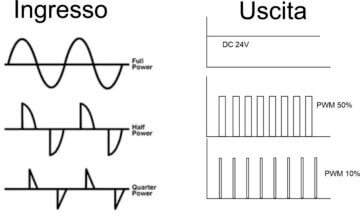From the end of the 80s, an innovative technology “for the time” revolutionized the lighting landscape: the TRIAC, a semiconductor device, made it possible to adjust the light simply and economically
At the time, the halogen lamp boom exploded and everyone, sooner or later, used “dimmers” to adjust the brightness in their homes. Technology stopped for decades, and TRIAC dimmers remained in vogue for many years with different versions and shapes, from recessed to wall, pedal, etc. Later came the analogue dimming systems, such as 0_10 and 1_10, which are still in use now, and system refinements, such as IGBT dimmers and MOSFETs, better conformed to the modern systems. With the decrease in power implied and the advent of LEDs, the regulation systems changed, and home automation introduced much more precise and effective digital systems, such as DALI, DMX, etc. The TRIAC systems declined in popularity and discarded due to their limitations in regulation, such as high minimum load, incompatibility with LEDs and mainly the flicker, which is literally a limitation of TRIAC regulation.
In Figure 1, the waveforms of the TRIAC control system; the mains voltage is interrupted progressively to limit the power in the load

Halogen bulbs have a filament with substantial thermal inertia, so the voltage changes introduced by the TRIAC are average, and the eye does not perceive any light vibration or flicker. However, when we go to adjust an LED load, which has no inertia and reacts instantly to voltage variations, we can perceive the TRIAC/IGBT adjustment as an annoying flickering that compromises the very popular photographic shooting or movies. The new standards have stringent requirements on the quality of light. TRIAC regulation adverse effects, such as flicker and the strobe effect, make the system obsolete and out of standard. Despite these limitations, millions of dimmers are still installed in our homes today, and the market continues to offer new dimming devices with the same principle.
From a regulatory point of view, that is one product that should disappear and instead remain on the market, creating quite a few problems for manufacturers of power supplies such as QLT.
The market demand for the dimming of LED systems with traditional TRIAC/IGBT dimmers is always high, and technology must give answers to overcome the technical defects that have appeared so far. LED power supplies adjustable from primary to TRIAC appear on the market. These power supplies, in addition to the low quality of the regulation, do not solve the flicker problem and reproduce on the LED load the variations of the network introduced by the dimmer, so from a regulatory and “photographic” point of view they are to be considered of low quality.
However, a new generation of power supplies has solved the problem, thanks to a new technology, by converting the input signal of the partialized network into a PWM regulation. That eliminates system defects.

This new technology makes it possible to use the “old” TRIAC devices to adjust the LED light in compliance with the updated quality parameters required by the regulations on FLICKER and Stroboscopic effect. Given the varied availability of TRIAC devices on the market, it is always better to use devices with an adjustable minimum to set a minimum stable light value during installation.
Qualitron offers power supplies in the classic 75 to 200W power adjustable to TRIAC primary side with efficiencies of over 92%.